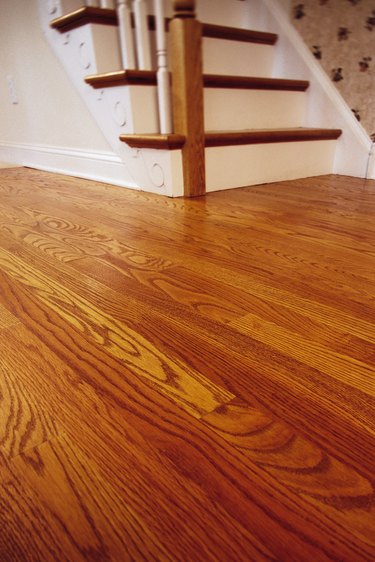
Wood floors add warmth and natural beauty to your home and can be a durable flooring choice that requires little maintenance. However, when moisture levels in the wood become unbalanced, or a sudden change occurs in your home's humidity, this type of floor may curl or warp. Repairing most curling or warping issues is possible, but only once the wood has dried and stabilized.
Cupping
Video of the Day
Moisture beneath the flooring or within the individual pieces of hardwood when it was installed can result in an upward curl or cupping, where the edges curl higher than the center of the wood pieces. Cupping develops gradually, often due to inadequate acclimation of the wood before installation. Wood floors will cup if installed in damp basements or if the concrete subfloor beneath did not properly cure before installation. Leaks from plumbing or appliances can also cause wood floors to cup. If your hardwood floor is curling like this, don't attempt to sand it flat until the sources of moisture have been addressed. Check the moisture level in your home and once it is gone, the flooring should dry to its original flat condition. However, this adjustment can take weeks or months to occur.
Video of the Day
Crowning
Crowning is a type of curling in wood floors where the center of the flooring pieces bends higher than the edges. Moisture may cause wood floors to crown, but more often the cause is sanding a previously cupped floor to correct the problem before it had time to dry and straighten out naturally. As a result, the floor boards dried in a crowned fashion because the edges were removed.
Warping
Warped or sagging floors are typically caused by significant moisture problems, such as flooding or leaks, and rarely result from improper installation. If you've experienced recent flooding, allow your floors time to dry and then reassess the extent of the damage. Some woods will straighten if given enough time to thoroughly dry. Floors that warp near appliances or that are installed over leaking plumbing pipes indicate significant moisture beneath them. This moisture must be eliminated before you can begin repairs.
Repair
Badly warped floors, where gaps or buckling have resulted must be replaced because they cannot be repaired. Floors that are only slightly warped need to dry completely before repair can be attempted. While drying, some boards may straighten out, and those that are still humped can be planed or sanded flat and then refinished. Pine flooring will often flatten out naturally once it has dried. This can take several months, though. Applying heat to the floor can help speed up the drying process. Sanding a cupped floor while it is wet can cause crowning later. If your flooring does not return to its proper shape after a heating season, it is likely to be permanently cupped. If the wood has dried, re-sand and finish your floors to correct the problem. Crowning can be repaired by re-sanding as well, once the floor has dried.